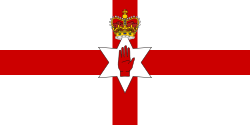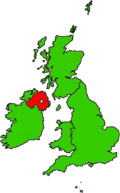Northern Ireland flags issue
The Northern Ireland flags issue is one that divides the population along sectarian lines. Depending on political allegiance, people identify with differing flags and symbols, some of which have, or have had, official status in Northern Ireland.
Common flags
- The flag of the United Kingdom, the Union Flag, is the only flag routinely used officially by the sovereign British government, as well as being flown on most council buildings in Northern Ireland.[1] The Union Flag is often flown by unionists but is disliked by nationalists. British law states that the Union Flag must be flown on designated days from central government buildings in Northern Ireland.[2]
- The Ulster Banner, the flag of the pre-1973 government of Northern Ireland, was used from 1953 to 1972 by the Stormont government to represent the government of Northern Ireland.[3] That government was granted a royal warrant to fly the Ulster Banner in 1924, but this expired when the government was dissolved under the Northern Ireland Constitution Act 1973. It continues to be used by some sports teams representing Northern Ireland internationally, for example by the Northern Ireland football team,[4] and by the Northern Ireland Commonwealth Games team.[5]
- The flag of Ireland or Irish tricolour is the state flag of the Republic of Ireland, and is regarded by republicans and some nationalists as the flag of all of Ireland.
- Other flags flown by socialist republicans include the Starry Plough and the Sunburst flag. Loyalists sometimes display the flag of Scotland as a sign of their Scottish ancestry. Ulster nationalists use the unofficial 'Ulster Nation flag', although it has now been adopted as an Ulster-Scots flag.
Controversies
The Flags and Emblems (Display) Act (Northern Ireland) 1954 prohibited the display of any flag which was "likely to cause a breach of public order", and gave the police powers to deal with it. However, it specifically excluded the Union flag from its provisions.[6] In 1964, the Royal Ulster Constabulary moved in to remove an Irish tricolour from the window of an office in Belfast, after Ian Paisley had publicly said that if they did not, he would do so personally. This resulted in serious rioting.[6] The Act was repealed in 1987.
In some loyalist areas the flying of flags supporting loyalist paramilitaries has proved controversial. Groups like the Ulster Defence Association, Ulster Volunteer Force, Young Citizen Volunteers, Red Hand Commando, and Loyalist Volunteer Force all have their own unique flags and although these flags usually appear alongside murals, they can occasionally be seen flying from lampposts in villages and towns or flying from houses in the run up to the Twelfth.
Some local councils have debated the usage of the Tricolour. In 2002 Belfast City Council displayed the Tricolour along with the Union Flag in the Lord Mayor's parlour during the term of Sinn Féin Lord Mayor Alex Maskey.[7] A different approach was taken in 1997; when the Social Democratic and Labour Party's (SDLP) Alban Maginness was Lord Mayor, neither flag was displayed. In September 2003, Belfast City Council discussed flying the Tricolour alongside the Union Flag on designated occasions.
The Ulster Banner continues to be used by some local governments, such as the predominantly unionist Castlereagh, which flies it outside its offices.[8]
A decision in December 2012 to fly the Union flag over Belfast City Hall only on certain designated days, instead of all the year round as previously, led to the Belfast City Hall flag protests, which included riots in which police officers were injured.[9]
The Haass talks
In 2013, US diplomat Richard Haass chaired talks between the political parties in Northern Ireland dealing with, among other things, the issue of flags. The resulting draft proposals, which were not agreed by the parties, included the idea of a new flag for Northern Ireland to replace the Ulster banner and the possibility of a "circumscribed role for the sovereign flag of Ireland in conjunction with the Union flag."[10]
See also
- Flag of Northern Ireland
- List of flags of the Republic of Ireland
- List of flags of the United Kingdom
- List of flags used in Northern Ireland
- Cross-border flag for Ireland
- Party Processions Act 1850 Act which banned "any Banner, Emblem, Flag or Symbol, the Display whereof may be calculated or tend to provoke Animosity between different Classes of Her Majesty's Subjects"
References
- ↑ "The Flags Regulations (Northern Ireland) 2000" (PDF). Northern Ireland Assembly. Retrieved 5 October 2011.
- ↑ The Flags Regulations (Northern Ireland) 2000
- ↑ Encyclopaedia Britannica says: According to British tradition, a coat of arms or flag is granted to the government of a territory, not to the people residing there
- ↑ "Northern Ireland". FIFA. Retrieved 5 October 2011.
- ↑ Commonwealth Games website. Choose "Northern Ireland" from the "Countries" menu.
- 1 2 Thomas Hylland Eriksen and Richard Jenkins, Flag, Nation and Symbolism in Europe and America, Routledge, 2007, ISBN 1134066961, p. 104
- ↑ "Tricolour raised in City Hall". BBC. 4 September 2002. Retrieved 2012-07-27.
- ↑ Castlereagh (1 January 1970). "Castlereagh Borough Council, Northern Ireland". Maps.google.com. Retrieved 26 September 2011.
- ↑ Belfast flag protests: Loyalists clash with police after rally, BBC, 8 December 2012
- ↑ John Mulgrew, "Final draft on dealing with Northern Ireland's past released after failure on agreement", Belfast Telegraph, 31 December 2013. Retrieved 28 January 2014
External links
- Symbols in Northern Ireland - Flags Used in the Region by Dara Mulhern and Martin Melaugh; illustrated article from CAIN Project (Conflict Archive on the INternet)



